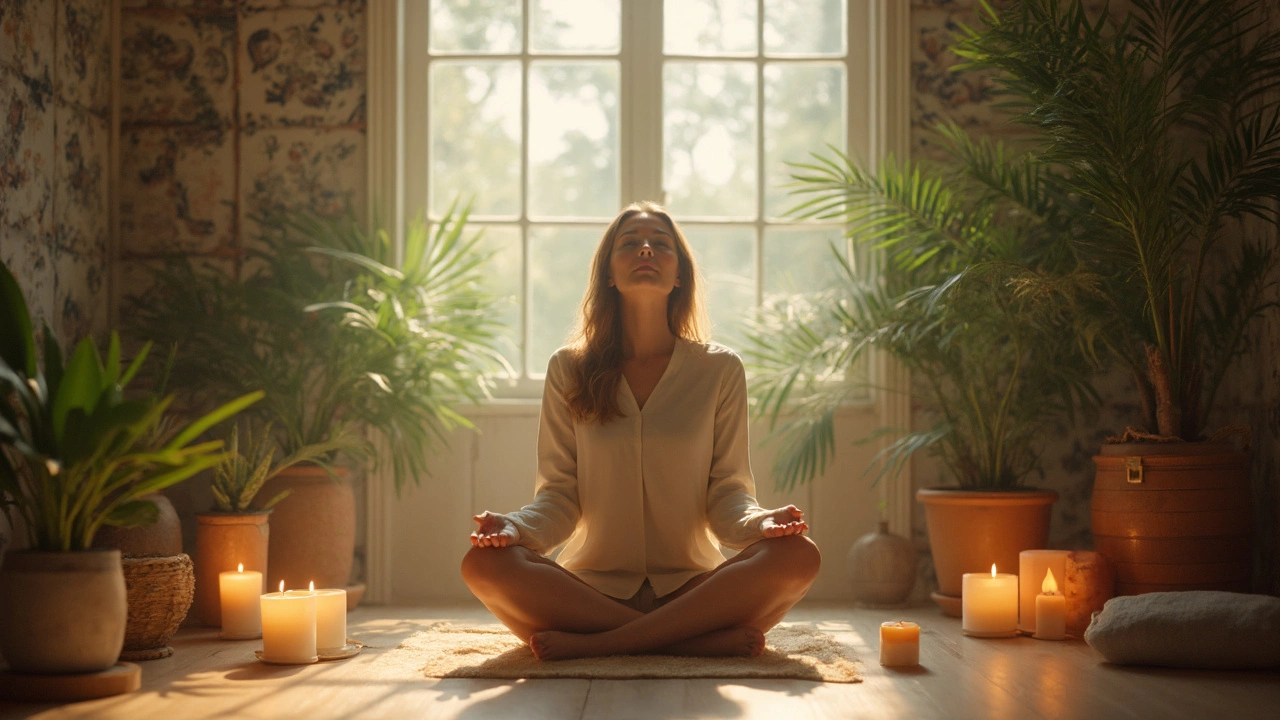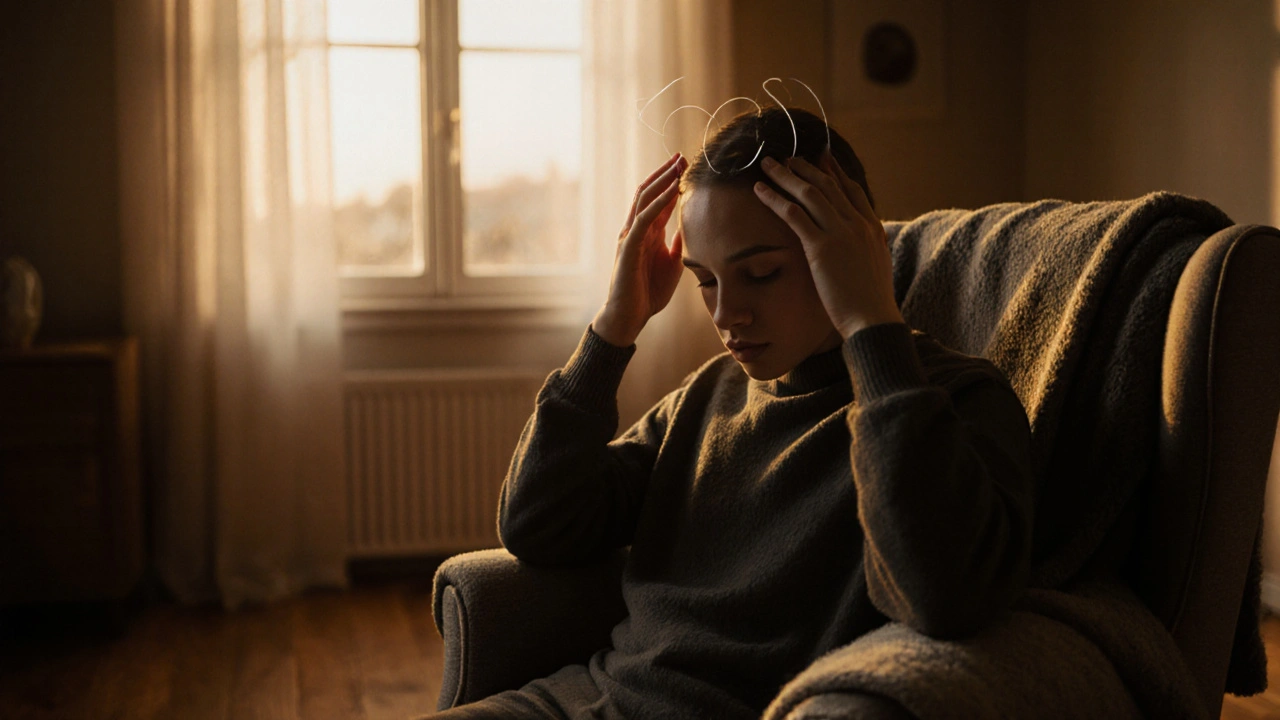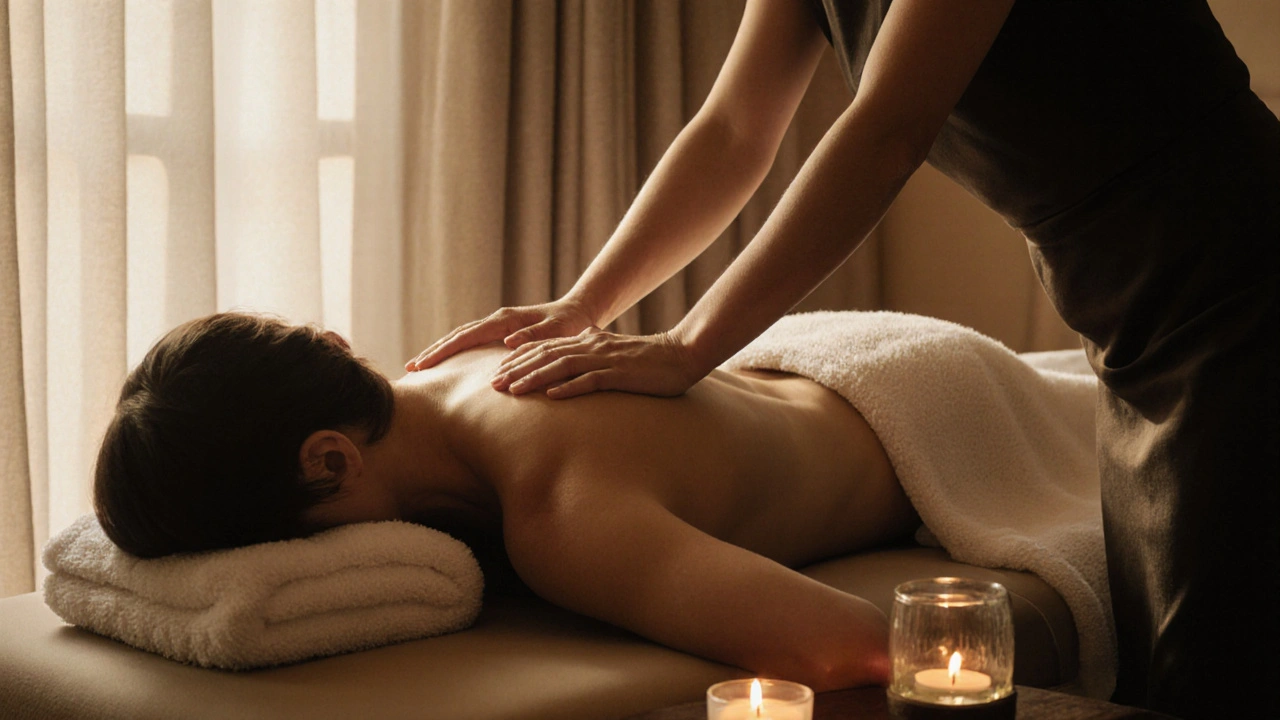Head Massage in Traditional Healing: Benefits, Types, and What to Expect

Ever wondered why cultures across the globe swear by head massages for feeling better? You're not alone—this simple touch-based therapy has roots going back thousands of years, and it's way more than just an excuse to relax.
If you've had a rough week, felt those nagging headaches creep in, or struggled to switch off at night, head massage can feel like pressing your body's reset button. In traditional healing, it's not just about loosening tight spots; it's believed to move energy, boost circulation, and bring balance back to both mind and body.
From Indian Ayurveda to ancient Chinese medicine, folks have leaned on head massages to tackle everyday stress, help the body heal faster, and even improve your mood. Science is catching up, too—some therapists point out that gentle kneading of your scalp can lower cortisol (the stress hormone), help headaches, and even give you glossier looking hair by boosting blood flow up top.
Curious to give it a go? Or want to understand a little more before you let someone get their hands on your head? You’ll find out the must-know basics, how to spot a good head massage service, and what to actually expect when you book a session. Plus, I've got some simple tips to make the most out of every minute—whether you’re in a luxury spa or just having a friend work out those knots at home.
- Key Takeaways
- Direct Answer: Why Head Massage Matters
- The Roots and Power of Head Massage
- Real-Life Benefits and Everyday Tips
- Different Styles Around the World
- How to Try or Book a Head Massage
Key Takeaways
If you want the quick facts on head massage and how traditional healing has used it for centuries, you’re in the right place. Here’s what really matters:
- Head massage isn’t a new trend—it’s been part of healing traditions like Indian Ayurveda and Chinese medicine for over 2000 years.
- It aims to boost blood flow to the scalp, relieve stress, ease headaches, and sometimes even improve sleep and hair health.
- There are several styles: Indian champissage (focusing on head, neck, and shoulders), Japanese shiatsu, Chinese acupressure, and even scalp reflexology.
- You don’t need to book a fancy session—simple at-home head massage techniques can still be super helpful for stress or tension headaches.
- Proper technique matters. Rubbing too hard or skipping sensitive areas can actually backfire, so following safe practice is key.
- People with certain conditions (like recent head injuries or infections) should talk with a doctor before trying a head massage.
| Benefit | Traditional Use | What Research Shows |
|---|---|---|
| Stress Relief | Calms nerves, balances energy | May lower cortisol levels (2016 study in Complementary Therapies in Medicine) |
| Headache Relief | Treats tension headaches and migraines | Up to 60% report fewer headaches after regular massage |
| Improved Sleep | Promotes relaxation, helps insomnia | Some massage patients fall asleep during sessions |
| Better Hair Health | Boosts circulation to follicles | May help with scalp health (small-scale Japanese studies) |
So, next time your brain feels like it’s running on empty, or you just want a way to unwind, know that head massage isn’t just relaxing—it’s a tool that’s stood the test of time.
Direct Answer: Why Head Massage Matters
Head massage isn’t just about feeling good for a few minutes. Across traditional healing systems, this simple treatment plays a real role in improving how you feel—physically and mentally. When someone massages your scalp, it stimulates nerves and blood vessels right under the skin, which actually helps increase blood flow to your head and neck. That’s not just nice; it’s tied to better hair growth, improved focus, and relief from tension headaches.
In Ayurveda, for example, head massage (called “Shiro Abhyanga”) is used to calm the mind, release built-up tension, and keep the nervous system balanced. Some Chinese and Japanese practices see the head as a key spot for unblocking energy (“qi” or “chi”), and gentle pressure here can help you feel more awake or relaxed, depending on what your body needs. So if you’re run-down or staring at screens all day, this isn’t just pampering—there’s actual science showing that regular scalp massage can cut down on stress hormones like cortisol and may even help you sleep better at night.
Here's why head massage matters most:
- Relieves tension – Helps with headaches and jaw stiffness, especially if you clench your teeth or spend hours on a laptop.
- Boosts circulation – Delivers more oxygen and nutrients to the scalp, which benefits your hair and brain function.
- Reduces stress – Promotes relaxation, relieves anxiety, and helps lower heart rate.
- Easy to access – You can do it yourself, book a pro, or ask a friend. No fancy tools required.
So the next time someone offers you a head massage, remember: you’re not just getting a treat—your body and mind are getting the support they need to reset and recharge.
The Roots and Power of Head Massage
Head massage isn't some recent trend—it’s actually a staple in traditional healing that’s stuck around for good reason. If you think it’s just about a quick scalp rub, think again. In India, people have used head massage for more than 2,000 years. It’s a key practice in Ayurveda, which is India’s traditional system of medicine. Here, head massage, or Champi, isn’t just about comfort. It’s believed to help energy (they call it ‘prana’) flow evenly in your body, so you feel balanced and refreshed.
Move to China, and you’ll hear about Tui Na, an ancient technique where head massage focuses on specific pressure points. The goal is to get your body’s energy, or 'qi,' moving freely. If you’ve ever noticed how a good massage can clear your mind, these old-school systems were onto it way before modern science caught up.
But what’s really happening when you get a head massage? Here’s a quick look at what traditional healing—backed by some recent research—says it can do for you:
- Boosts blood flow to the scalp and brain, which can help sharpen focus and promote healthier hair.
- Keeps tension headaches and migraines at bay by relaxing tight muscles and calming nerves.
- Reduces stress by triggering the body’s natural relaxation response—think lower heart rate and slower breathing.
- Helps you sleep better, especially if worry or racing thoughts keep you up at night.
Fun fact—early records show even ancient Egyptians and Greeks got head rubs to prep their minds for big events. Fast forward to now, and studies suggest regular head massages may lower levels of cortisol (the stress hormone) by as much as 31% in some folks. That’s not just folklore; it’s real, measurable impact.
| Culture | Term for Head Massage | Main Purpose | Known Benefit |
|---|---|---|---|
| India | Champi | Energy flow, balance | Reduces stress, boosts scalp health |
| China | Tui Na | Qi movement | Headache relief, mental clarity |
| Japan | Shiroabhyanga | Relaxation, sleep | Improved rest, relaxation |
Old or new, the power of head massage is all about tapping into your body’s natural healing. It’s easy to see why this tried-and-true method still gets recommended by both grandmas and modern therapists.

Real-Life Benefits and Everyday Tips
Ready for some real talk about what a good head massage can do? Let’s skip the fluff—these benefits show up in everyday life, not just in spa brochures.
First up, there’s stress relief. Massaging your scalp and neck drops stress hormones—cortisol—by almost 30%, according to a 2016 study published in the Journal of Physical Therapy Science. That means a calmer mind and fewer bad moods ruining your evenings. Ever felt your headache slip away after someone rubbed your temples? Those who get regular head massages actually report fewer migraines and tension headaches. Some people even find it helps with jaw pain and tight shoulders. The reason? Massaging anywhere on the scalp signals your body to chill out and sends a rush of blood to hungry brain cells and tight muscles. Your whole upper body can feel less tense after twenty minutes.
There’s a hair bonus too—folk remedies in places like India and Thailand have always linked head massage to a healthier scalp and thicker, glossier hair. Studies show increased blood flow can wake up sluggish hair follicles, encouraging stronger hair growth and less fallout. It won’t reverse baldness, but it’ll make what you’ve got look a whole lot better.
Check out this quick table for an at-a-glance look at head massage perks compared to other popular relaxation methods:
| Benefit | Head Massage | Full Body Massage | Meditation |
|---|---|---|---|
| Relieves Tension Headaches | ✅ | ⚪ | ⚪ |
| Boosts Hair & Scalp Health | ✅ | ⚪ | ❌ |
| Quick Stress Relief | ✅ | ✅ | ✅ |
| Easy to Do at Home | ✅ | ❌ | ✅ |
Want to try it for yourself without booking an appointment? Here’s what you can do:
- Gently press your fingertips on your scalp in small circles for five minutes. Focus around your temples, behind your ears, and the base of your neck — that’s where most folks carry tension.
- Use a little hair oil or lotion if your scalp feels dry. A few drops go a long way, and you’ll get that healthy scalp bonus.
- Got a buddy nearby? Even a short, two-minute temple massage from a friend can boost your mood fast. Take turns—both people win.
If you want the benefits but prefer a pro touch, many salons offer express scalp massages for less than a full-service treatment. Ask around—chances are there’s an option that fits your budget and schedule. Trust me, it’s worth trying at least once when you’re feeling fried after a busy week.
Different Styles Around the World
Head massage isn’t a one-size-fits-all deal. Different cultures have cooked up their own ways to help people feel better, making each style unique. Let’s break down a few well-known methods so you know what you’re getting, no matter where you book a session.
Head massage in India is called Champissage, or more commonly, Indian Head Massage. This practice has roots in Ayurveda and goes back over a thousand years. The therapist focuses on your scalp, neck, and shoulders, using a mix of kneading, tapping, and gentle pressure. Oils like coconut or sesame are often used not just for relaxation, but to strengthen hair and nourish the scalp. Indian Head Massage is usually done while you sit in a regular chair, not on a massage table, which makes it really accessible.
Next up, China’s got its own version, known as Tui Na. The Tui Na head massage blends acupuncture points (they call them acupressure points) with strong, precise finger pressure and rubbing rhythms. It’s not just about feeling good—Chinese medicine at its core aims to get your “qi” or energy flowing, so you leave feeling balanced and alert. Tui Na sessions might include scans for tension or energy blockages, and the massage can get pretty deep if you need it.
Japan has something special, too. Ever heard of Shiatsu? That simply means "finger pressure." Japanese Shiatsu head massages involve steady pressing, holding, and sometimes gentle stretches around the head and neck. Some spas even throw in facial massage to help with headaches or jaw tension. This method is popular for people who want a calm, methodical touch over fast movement.
Western countries have started mixing these styles with their own flair. You’ll find spa menus offering Swedish-inspired scalp massages or using essential oils like lavender for an extra chill vibe. These focus on relaxation, sometimes combining scalp rubs with hot towels or aromatherapy as an add-on.
Here's a quick table to compare the most common styles you might come across:
| Region | Style | Main Techniques | Typical Oils/Tools | Key Benefits |
|---|---|---|---|---|
| India | Indian Head Massage (Champissage) | Kneading, tapping, circular pressure | Coconut, sesame oil | Relaxation, hair and scalp health |
| China | Tui Na | Acupressure, rubbing, friction | Sometimes herbal oils | Energy flow, tension relief |
| Japan | Shiatsu | Finger pressure, holding, gentle stretching | Minimal oil, dry technique | Stress reduction, tension release |
| Western | Swedish-Style, Aromatherapy Scalp Massage | Gentle rubbing, kneading | Essential oils (lavender, chamomile) | Relaxation, improved sleep |
One smart tip: don’t be afraid to ask your therapist about the style they use, or mix and match techniques to suit your needs. What matters most is you leave feeling lighter, looser, and a little more in control of your well-being.
How to Try or Book a Head Massage
So you're ready to experience the magic of a head massage? Good call—it's one of those simple pleasures that really pays off for your body and mind. Whether you're curious to try it yourself or want to book with a pro, here's how to get started without any guesswork.
First, you’ve got two solid options: self-massage at home or visiting a trained practitioner. If you're new, it's smart to try a quick self-massage to see how your scalp and neck respond. All you need is your hands and about five to ten minutes. Use your fingertips (not nails) to make gentle, little circles along your scalp, starting at your hairline and working back. If you're sitting at your desk right now, give it a go—you’ll notice a difference.
If you’re after deeper relaxation, more targeted relief, or a taste of different traditional techniques like Indian Champissage or Japanese Shiatsu, booking a professional session is the way to go. Look for spas, wellness clinics, massage therapy centers, or even salons. Many places offer head massages as part of a package, so ask about add-ons like essential oils or extended scalp therapies.
When choosing a service, consider these:
- Check therapist credentials—look for licensing and customer reviews.
- Ask what styles they offer (Ayurvedic, Thai, Shiatsu, basic relaxation, etc.).
- Compare prices and see what’s included. Some head massages come with upper back, shoulder, or face work, while others stick to just the scalp.
- Look for places with clear hygiene standards. Professional places usually list safety measures on their sites, which is reassuring.
Want the numbers? Here’s a quick comparison of session types and costs from a 2024 industry survey of urban wellness centers:
| Type | Session Length | Average Price (USD) |
|---|---|---|
| Basic Scalp Massage | 20-30 min | 30-45 |
| Ayurvedic Oil Massage | 30-45 min | 50-80 |
| Spa Head & Shoulder Combo | 45-60 min | 65-100 |
Booking is way easier these days. Most places have online scheduling—you can book, reschedule, or even pay right from your phone. If you prefer, a quick call gets the job done, too. When booking, mention any particular concerns (like migraines or tension points) so your therapist can tailor the session for you.
One last tip: if you're unsure about which service to pick, just ask the receptionist or check the FAQ on their website. They’ll point you in the right direction based on your needs. And don’t forget to drink water before and after your massage—your body will thank you.


